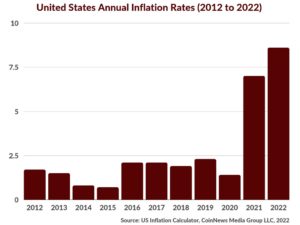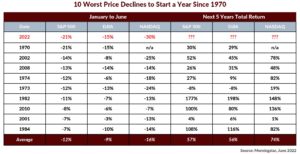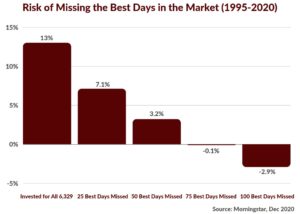By Mitch York | July 6, 2022
- Inflation has hit a 40-year high. We expect “demand destruction” to cause a significant decline in inflation by year-end, but remain elevated above normal levels.
- Once behind the curve, the Fed is front-loading large interest rate hikes in order to cool the economy and fight inflation.
- Stocks are off to their worst first half of a year since 1970, and bonds their worst start ever, but markets are resilient, and they recover.
Click to download this report
Economic Commentary
As the second quarter ends, the hot topics on everyone’s minds are:
- Has inflation peaked, and if not, when will it peak?
- What is the Fed doing about it?
- Will the Fed drive the economy into a recession? If so, how severe will it be?
We know why we have inflation. It’s the result of unequal supply and demand caused by the pandemic. The combination of a money supply expansion during the Covid-19 lockdown, the release of pent-up demand once the lockdown ended, and supply chain disruptions have sent inflation to a 40-year high.
This year, two new supply constraints arose – the Zero-Covid Policy in China, where many goods are manufactured, and the Ukraine War, creating shortages in energy and food.
The result? According to the U.S. Labor Department, inflation has jumped to 8.6% for the 12-month period that ended in May.1

So, what can we look forward to? It is likely that supply chain challenges will remain as China and Russia will remain wildcards. However, it’s unlikely that inflation will be this high at the end of the year as the demand side of the equation becomes front and center. Pent-up demand will eventually wane, a natural cure for high prices is high prices, and the Federal Reserve is finally acting with conviction.
The Fed has kicked the wheels of demand destruction into motion. They are front-loading significant interest rate hikes, the latest a 0.75% hike in June. Fed member expectations of future hikes indicate 3.4% by year-end. In addition, the Fed commenced “quantitative tightening” in June – an activity that reduces money supply and slows down the lending activity of banks.
There is evidence that the Fed is starting to get what it wants as higher interest rates on mortgages are taking a toll. Housing starts have fallen off a cliff, declining 14.4% from April to May and -8.6% from a year earlier. New mortgages have plunged an incredible 32% year-over-year as well. The housing market is the first shoe to fall as demand destruction becomes a reality.2,3
The Fed’s aggressive actions are not without risk. At this point, the Fed’s position has changed from “not moving fast enough to curb inflation” to “moving so fast it will cause a recession.” But this change in perspective just shows how complicated things are. The aggressive, front-loaded interest rate hikes have ironically increased expectations that the Fed will cut rates as soon as 2024. We know from history, that interest rate cuts and loosening of monetary policy lead to robust growth. Expect the recession, if it comes to fruition, to be relatively mild and short-lived.
Market Commentary
With inflation surging to 40-year highs, supply chain issues lingering, and the Fed instituting the largest rate hike in 28 years, the financial markets have plummeted. The S&P 500 and NASDAQ indices have sunk into bear territory, down 21% and 30%, respectively. The Dow (DJIA) keeps flirting with that unfavorable distinction and is currently down 15% through the first two quarters. For the S&P and DJIA, this is the worst start to a year in over 50 years. For the NASDAQ, it is the worst ever.4

While bonds should provide a buffer when markets crash, U.S. Treasuries have also delivered double-digit losses to start the year. The 10-year Treasury has lost more than 10%, and declines in longer-term Treasuries exceed 20%. Investment-grade corporate bonds have dropped a staggering 16%, and the Bloomberg US Aggregate Bond Index, tracking all maturities of Treasuries and corporate bonds, is on pace for its worst year in history, currently down over 10%. Unfortunately, this means the usually reliable balanced portfolio of 50% stocks and 50% bonds has declined more than 14% to start the year.4,5
Final Thoughts
The constant barrage of pessimism, lingering inflation, and recession talk from financial news organizations has everyone scared and gloomy. Still, it’s important to reflect on the past 25 years. We’ve seen dramatic conditions in the economy and markets before, so there is truly nothing new under the sun.
In the late 1990s, Russia defaulted on its debt. Then came the bursting of the Dot-Com Bubble, followed by 9/11. Soon after, a downgrade of U.S. debt, a housing market crash, and the bankruptcy of Wall Street bastion Lehman Brothers led to the Great Recession. And, most recently, a global pandemic shut down the global economy for months.
During those tumultuous periods, many people thought they knew what was happening and sold stocks or stopped putting money into the markets. However, one common theme has continually persevered – markets are resilient. Back in 1997, knowing all the pending economic and market calamities, would anyone have guessed the S&P 500 would generate an average annual of nearly 10% and a cumulative return of more than 900% over the next 25 years?6
In conclusion, there’s nothing new here; we’ve seen this before. Markets are resilient, and they recover. With so much risk currently priced into the markets, there is opportunity. Forward-looking stock valuations have declined dramatically, and yields on bonds are at multi-year highs. Despite an unbelievable lineup of bad news, if you have a long-term focus, you need to look past these things, even if it’s painful.

Times like these remind us how important it is to consult with your advisor to make sure your portfolio is aligned with your risk tolerance and time horizon. It’s this valuable partnership between the Client, Advisor, and CAM that will help guide you through these uncertain times by making prudent decisions and avoiding costly mistakes.
Author

Mitch York
CIO
Concord Asset Management
—
Footnotes and Sources
1Current US Inflation Rates: 2000-2022, US Inflation Calculator, June 10, 2022
2Troy Green, “Existing-Home Sales Fell 3.4% in May; Median Sales Price Surpasses $400,000 for the First Time,” National Association of REALTORS®, June 21, 2022.
3Mika Pangilinan, “Mortgage Applications Inch Higher in Weekly Survey,” Key Media, Inc, June 29, 2022.
4Morningstar, June 2022.
5Bloomberg US Agg Total Return Value Unhedged USD, Bloomberg, June 23, 2022.
6Information based on a portfolio of 50% Bloomberg US Aggregate Bond Index, 40% S&P 500 Index, and 10% MSCI EAFE Index.
Investing involves risks, and investment decisions should be based on your own goals, time horizon, and tolerance for risk. The return and principal value of investments will fluctuate as market conditions change. When sold, investments may be worth more or less than their original cost. The forecasts or forward-looking statements are based on assumptions, may not materialize, and are subject to revision without notice. The market indexes discussed are unmanaged, and generally, considered representative of their respective markets. Index performance is not indicative of the past performance of a particular investment. Indexes do not incur management fees, costs, and expenses. Individuals cannot directly invest in unmanaged indexes. Past performance does not guarantee future results. The Dow Jones Industrial Average is an unmanaged index that is generally considered representative of large-capitalization companies on the U.S. stock market. Nasdaq Composite is an index of the common stocks and similar securities listed on the NASDAQ stock market and is considered a broad indicator of the performance of technology and growth companies. The MSCI EAFE Index was created by Morgan Stanley Capital International (MSCI) serves as a benchmark of the performance of major international equity markets, as represented by 21 major MSCI indexes from Europe, Australia, and Southeast Asia. The S&P 500 Composite Index is an unmanaged group of securities that are considered to be representative of the stock market in general. U.S. Treasury Notes are guaranteed by the federal government as to the timely payment of principal and interest. However, if you sell a Treasury Note prior to maturity, it may be worth more or less than the original price paid. Fixed income investments are subject to various risks including changes in interest rates, credit quality, inflation risk, market valuations, prepayments, corporate events, tax ramifications, and other factors. International investments carry additional risks, which include differences in financial reporting standards, currency exchange rates, political risks unique to a specific country, foreign taxes and regulations, and the potential for illiquid markets. These factors may result in greater share price volatility. Please consult your financial professional for additional information. This content is developed from sources believed to be providing accurate information. The information in this material is not intended as tax or legal advice. Please consult legal or tax professionals for specific information regarding your individual situation. The opinions expressed and material provided are for general information, and they should not be considered a solicitation for the purchase or sale of any security.
Concord Asset Management, LLC (“CAM” or “IA Firm”) is a registered investment advisor with the Securities and Exchange Commission. CAM is affiliated, and shares advisory personnel, with Concord Wealth Partners. CAM offers advisory services, including customized sub-advisory solutions, to other registered investment advisers and/or institutional managers, including its affiliate, Concord Wealth Partners, LLC. CAM’s investment advisory services are only offered to current or prospective clients where CAM and its investment adviser representatives are properly licensed or exempt from licensure.
The information provided in this commentary is for educational and informational purposes only and does not constitute investment advice and it should not be relied on as such. It should not be considered a solicitation to buy or an offer to sell a security. It does not take into account any investor’s particular investment objectives, strategies, tax status, or investment horizon. You should consult your attorney or tax advisor.
The views expressed in this commentary are subject to change based on the market and other conditions. These documents may contain certain statements that may be deemed forward‐looking statements. Please note that any such statements are not guarantees of any future performance and actual results or developments may differ materially from those projected. Any projections, market outlooks, or estimates are based upon certain assumptions and should not be construed as indicative of actual events that will occur.
Please remember that past performance may not be indicative of future results. Different types of investments involve varying degrees of risk, and there can be no assurance that the future performance of any specific investment, investment strategy, or product (including the investments and/or investment strategies recommended or undertaken by CAM or its affiliates, or any non-investment related content, made reference to directly or indirectly in this newsletter will be profitable, equal any corresponding indicated historical performance level(s), be suitable for your portfolio or individual situation or prove successful. Due to various factors, including changing market conditions and/or applicable laws, the content may no longer be reflective of current opinions or positions. Moreover, you should not assume that any discussion or information contained in this newsletter serves as the receipt of, or as a substitute for, personalized investment advice from CAM or CWP. To the extent that a reader has any questions regarding the applicability of any specific issue discussed above to his/her individual situation, he/she is encouraged to consult with the professional advisor of his/her choosing. IA Firm is neither a law firm, nor a certified public accounting firm, and no portion of the newsletter content should be construed as legal or accounting advice. A copy of IA Firm’s current written disclosure Brochure discussing our advisory services and fees is available upon request or at https://concordassetmgmt.com/.
Please Note: If you are an IA Firm client, please remember to contact IA Firm, in writing, if there are any changes in your personal/financial situation or investment objectives for the purpose of reviewing/evaluating/revising our previous recommendations and/or services, or if you would like to impose, add, or to modify any reasonable restrictions to our investment advisory services. IA Firm shall continue to rely on the accuracy of the information that you have provided. Please Note: If you are an IA Firm client, please advise us if you have not been receiving account statements (at least quarterly) from the account custodian.
